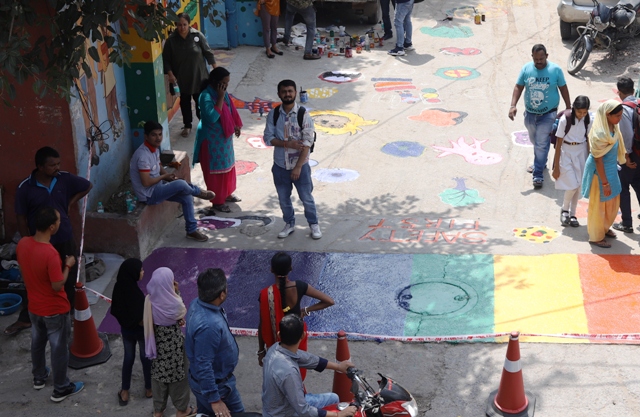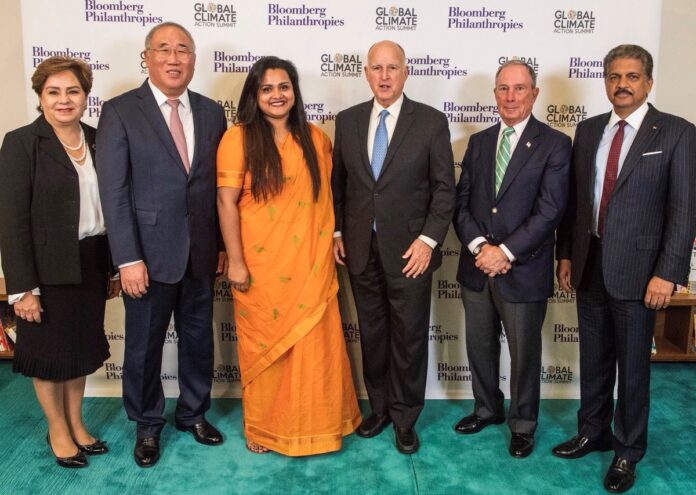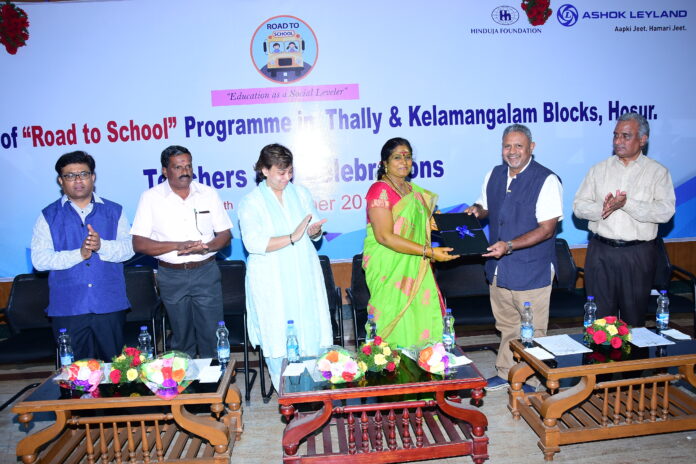Bharti Foundation expands Satya Bharti Program to Karnataka
Bharti Foundation, the philanthropic arm of Bharti Enterprises, today announced that it has signed a Memorandum of Understanding (MoU) with the Education Department, Government of Karnataka to implement its Satya Bharti Quality Support Program at 30 government schools in Ramnagara District. As part of the MoU, Bharti Foundation will work in partnership with Government schools to enhance the overall schooling experience of the students and the teachers. The initiative marks Bharti Foundation’s entry into the State of Karnataka.
The Government will continue to own, manage and run the schools and provide its ongoing support to the school with its financial resources, teachers, infrastructure facilities and expansion as per the State’s annual plan. Currently, the Satya Bharti Quality Support Program is directly impacting close to 2,00,000 students and more than 7000 teachers across 12 states of India.
Vijay Chadda, CEO, Bharti Foundation said, “We are delighted to partner with the Government of Karnataka and are committed to jointly work with the State Education Department to drive the Government’s agenda of enriching schooling experience in the State. Our holistic development approach and school improvement plan involves working in close coordination with all stakeholders – the school leaders, educationists and officials in the Department.”
Bharti Foundation’s Satya Bharti Quality Support Program is an education initiative run in partnership with Government Schools. Through this program, Bharti Foundation engages with the school leadership, teachers, students and local communities to enhance schooling experience and strive for excellence. The approach focuses on identifying, integrating and optimising best practices from Satya Bharti Schools from across the country with the intent of encouraging innovation, participation, ownership and facilitating sustainable change.
Bharti Foundation, the philanthropic arm of Bharti Enterprises, was set up in the year 2000. Since inception the Foundation has reached out to 3,00,000+ students and 13,000+ teachers through more than 2100 schools/centres across 15 States through its initiatives in the education sector.
Cultivating Art Awareness
Picture making, drawing and painting is as ancient as mankind itself. Man expressed himself by observing human forms, other living beings and objects around him, sketching them on walls, paper, and cloth and other surfaces. Kala Drishti’s aim is to cultivate awareness and eye for an art.
Kala Drishti presents an art heritage collection conceptualized by ANJALI and RITIKA JAIN. It was in the beginning of the 19th Century that the contemporary Indian art was started by great artist like Raja Ravi Verma and the Bengal school of artists who won acclaim worldwide and whose work was held in great esteem. Yet, despite having world renowned artists whose works sell in Sotheby’s and other famous auctions, the visual art scene has yet to grow and find its right place in India. It has very few patrons and most of the people have yet to understand the so-called “modern art” which they think is nonsense and buying art a waste of money. It is very difficult for the upcoming and promising artist to find recognition for their work.
Kala Drishti is a trust formed by artists, aimed to promote upcoming and struggling artists so that they are able to achieve reasonable success in their field. They are determined to achieve the maximum and give the upcoming artists their rightful place in the sun. It organizes exhibitions, workshops, symposiums, buyer seller meets and also plans to have its own gallery, shops, schools art libraries and art cafes.
Kala Drishti is running a campaign in Karkardooma Village where they are holding free art summer camps for children and skill-based workshop for mothers. Through these camps, they are running cleanliness drive to convert the village into an art village under the guidance of professional artists. The children are handpainting dustbins. The women are manufacturing beautiful decor items for homes. Kala Drishti recently participated in Kachra Mahotsav and encouraged associated artists to create ART out of waste.
To know more and contribute to the project, write to us at editor@thecsrjournal.in
Second season of ‘SBI Green Marathon’ in 15 cities
With the remarkable success of the inaugural edition of SBI Green Marathon, the commercial bank announces the launch of its 2nd season. In its second edition, this mega event will be held in 15 cities across the country pledging for a greener future. The event is going to be a zero-waste event and is expected to witness close to 75,000 participants who will run to spread awareness about the importance of cleaner and greener globe.
SBI General Insurance is going to be the health partner for SBI Green Marathon whereas SBI Life, SBI Mutual Funds and SBI Cards are also significantly contributing to this cause. The 15 city marathon event will start from September 30, 2018 in New Delhi followed by Lucknow, Hyderabad, Mumbai, Kolkata, Bangalore, Trivandrum, Guwahati, Bhopal, Bhubaneshwar, Chennai, Chandigarh, Ahmedabad, Patna and concluding in Jaipur on March 4, 2019. The run category for this fiscal’s SBI Green Marathon would include 5K, 10K and 21K.
Prashant Kumar, DMD & CFO, SBI said, “We hope for maximum participation from across the country which in-turn will help us achieve the goal of a greener future.” The “Run for Green” theme of this marathon event recognizes every participating individual as agents of change for a greener globe. All the participants will be given organic t-shirts to promote healthy and greener city. Even the runners’ bib would consist of seeds which can be planted after the Marathon. Also bio-degradable and recyclable material is to be used by the bank making this a zero waste event.
4 Types of Scam Calls to Beware of
In a country like ours where mobile numbers and addresses are for sale in bulk databases, the field is open for fake scam calls and cyber fraud. Few privacy laws make it difficult to screen the frauds from the real deal. The worst-hit are the elderly who may not be conversant with digital lingo.
Types of scam calls
In the interest of public awareness, we present the most common types of such scams, so you don’t fall prey to them, dear reader.
1. Investment fraud
By sourcing the contact details and available account information for savings or investment account holders, fraudsters can adopt the persona of an investment broker. They will then contact you to entice them with easy and profitable opportunities, but they seem a lot more trustworthy because they talk about accounts you already own and real results. Of course, they have bought the information on your investments from corrupt sources but you don’t know that!
2. Phishing scam
Phishing is a broad term for attempts by scammers to trick you into giving out your personal information – bank account number, passwords and credit card number, for instance. These scammers will contact you out of the blue, via email, text message, phone call or even through social media, pretending to be a legitimate business such as your bank or even internet provider.
The scammer may politely ask you to update them on your details so they can refresh their systems. Another scam call trick is to fill out a survey with the assurance of a free gift on completing it. This is where the scammer gets access to your email address, phone number etc.
Another way these scammers get hold of your information is to tell you that ‘unauthorised or suspicious activity has been happening on your account’, and they will then ask you for your information so they can “sort it out”. In fact, they are the ones who are going to steal from you.
3. Mobile banking and e-wallet
The surge in mobile wallet apps after demonetisation gave another opportunity for scammers to cash in. These calls could to be made to the elderly to “assist” them on getting a so-called “account” on BHIM / Paytm or other mobile wallet apps. A fraud executive calls you pretending to be from one of these reputed mobile banking and e-wallet companies, and declares that he will guide you through the registration process by taking your banking details. Ultimately, the aim of the scam calls is to gather confidential banking information.
4. Fake Income Tax officer
For an elderly citizen or a person who doesn’t fall into a tax bracket, getting a call from the Income Tax Department is next to impossible. Do not reveal any details to the so-called “IT officer” no matter how convincing he sounds.
How to deal with them
In reality, no banker will ever ask for any card or account-related details. Banks mostly communicate via email or would ask you to visit your registered branch. The best way to deal with scam calls is to ignore them or tell the caller that you will go to the bank to enquire about any problems. Disconnect within seconds. Never ever reveal any details about yourself.
Non-Indian Brands That Contribute Heavily Towards CSR In India
India is a country with second largest population. It has most number of young population in the world. This has attracted several international companies to enter the Indian market for business purposes. Over time, these multinational companies have made a home in the country by investing huge capitals to build their headquarters in India, and recruiting thousands of Indian youth. Apart from this, they have also participated heavily in national and social development in the country by investing in India CSR. Below is the list of 10 such companies.
- Coca Cola
Coca Cola is an MNC with its corporate office in Atlanta, Georgia in the USA. It started its operations in India in 1993. The company has launched a non-profit organisation called Coca-Cola India Foundation. The foundation’s focus areas include watershed management protection and development, purification of riverine systems, creation of integrated water bodies, restoration of old water bodies and rural electrification through solar energy. The foundation has implemented projects in various states of India.
- Microsoft
It is difficult to imagine work at office without Microsoft’s flagship enterprise software by the same name. Microsoft is one of the most successful MNC’s in India and they have man parallel programs for CSR in India. Youth Spark – Project Jyoti, the community technology skills program is one of their flagship programmes for skill development in India. Over the years, they have trained almost half a million adults who are in gainful employment or self employed.
- Nestle
Nestle, the FMCG company from Switzerland entered India in 1912. Since then, it has contributed to India CSR with its initiatives in healthcare, nutrition, reduction of water wastage, waste management and sustainable solutions. It’s Healthy Kids Program initiative has reached out to over 200,000 beneficiaries across 21 states in India.
- Procter and Gamble
P&G with its corporate office located in Ohio, USA is known for their world class products and glitzy ad campaigns. But they also promote a lot of initiatives using their brand equity among people. Their Shiksha initiative is working extensively to provide necessary amenities from building classrooms to building toilets, providing clean drinking water to setting up drinking water stations and playgrounds across India.
- Pepsico
PepsiCo, a North American food giant has a very strong presence in India and has used Indian Brand ambassadors since the heydays. Behind the scenes they also do a lot of social work at the ground level. They partner with a lot of NGO’s who specialise in a certain social sector to bring about a change in the society. From Akshay Patra to Working with ADI – Alternative Development Initiative, PepsiCo is here to make a difference.
Google is so successful that it has now become a verb. We can’t imagine internet without Google’s search engine. The organisation has pioneered initiatives to provide Internet access to all. The Internet Saathi program has impacted 10 million women and taught them how to use internet to open the doors to the world. Railwire – a joint initiative between Indian Railways and Google to provide free internet at railway station is a roaring success. More than 8 million people get access to internet on a daily basis using Railwire.
- Hindustan Unilever
Lifebuoy which is owned by HUL has pioneered hand washing in India. Lifebuoy’s campaign – Help a child reach the age of 5 created a lot of awareness about sanitary conditions and their effects on people. Lifebuoy along with brand ambassador visit schools and instil the habit of regularly washing hands before meals. Their other brands also promote WASH (Water, Sanitation and hygiene).
- Citibank
Citibank is an subsidiary company of Citi Group which is an American Banking Services Corp. It has more than 40 branches in over 30 cities in India. The Citi Foundation, the CSR wing of Citibank supports programs that enable the poor to access the formal financial sector, improve production skills, establish sustainable enterprises and manage their finances better. In 2012 Citi India partnered with 11 NGOs and committed grants totalling more than INR 98 million towards Financial Capability and Asset Building, Youth Education and Livelihoods, Enterprise Development and microfinance.
- McDonald’s India
McDonald’s, the world’s largest hamburger fast food chain, made its entry in India in 1996. The company has launched several products specially designed for the Indian markets making McDonald’s India’s menu, most creative and innovative among its other branches. Making it a home, McDonald’s India has given back a lot with its CSR initiatives in Education, Nutrition, Eye care, water conservation, energy saving, adoption and environment sustainability.
- HP
Hewlett Packard is an American IT company which democratised access to computer’s by bringing down their price and size of the machine. In India, the World on Wheels program is a 20 sweater full fledged IT lab which provides knowledge and empowers people in far away areas by making them digitally literate.
Thank you for reading the story until the very end. We appreciate the time you have given us. In addition, your thoughts and inputs will genuinely make a difference to us. Please do drop in a line and help us do better.
Regards,
The CSR Journal Team
CSR: Ensuring Road Safety Through Street Art
Every year, pothole-related deaths make it to the headlines especially during the monsoon season, causing inconvenience but also taking lives. Media reports state potholes took a deadly toll in 2017, claiming almost 10 lives daily with annual fatalities in the country adding up to 3,597 — this figure is 50% more than what was recorded in 2016.
Broken footpaths, dislocated kerb stones, missing signages, affecting traffic movements and potholes have become some of the grave issues in our day to day life. Road accidents and potholes are avoidable tragedies. Too often, children don’t spot the pothole till it is too late.
A quirky campaign is combining street art with basic safety rights to bring the attention of government authorities concerned to the issue of potholes. SEEDS (Sustainable Environment and Ecological Development Society) organized a ‘Painting the potholes’ campaign at secondary school, Khichripur Village, East Delhi as a part of the Honeywell Safe Schools Program. It aims to creatively make them visible, helping avoid mishaps and safeguard children. Working around the school neighbourhood, a rainbow crossing was also painted at a major traffic junction. In this vicinity in East Delhi, the majority of children walk to school. As the Honeywell Safe Schools baseline study showed, road safety is a major concern for parents. Lack of road discipline coupled with the issue of potholes is aggravating the risk of mishaps in the city.
“Painting the potholes is a unique idea to bring attention to the cause,” said Anuradha Madan, Principal, Govt. Co-ed Secondary School, Khichripur Village, East Delhi. “Bright colours will not only help attract attention to save lives, but attention to help resolve these issues. When it comes to road safety, children have an important role to play in the conversation,” said Shalini Sunny, School Coordinator, Honeywell Safe Schools.
Mahindra Group to go Carbon Neutral by 2040
Mahindra & Mahindra (M&M) has announced its commitment to become a carbon neutral company by 2040. Mahindra will focus on energy efficiency and the use of renewable power to achieve this target. Residual emissions will be addressed through carbon sinks. Anand Mahindra, Chairman, Mahindra Group and co-chair of the Global Climate Action Summit currently under way in San Francisco committed that his entire group of businesses would become carbon neutral.
This is significant because earlier Mr Mahindra had pledged that only its flagship company – Mahindra & Mahindra – would become carbon neutral by 2040. However, after listening to leaders speak at the Summit, he upped the ante on his commitment by extending that pledge to the entire group. “We are doing our part in the global fight against climate change with this ambitious new target. Mahindra will leverage the latest technological advances and its recently announced Carbon Price to work towards being carbon neutral by 2040,” he said.
The company has more than 10 years of experience in creating carbon sinks. It looks forward to using this experience to deal with residual emissions in a manner that is world class and follows the best established protocols. M&M will be working on its carbon neutrality commitment with the international non-profit organization Environmental Defense Fund (EDF), which works with leading companies to raise the bar for corporate sustainability leadership. M&M is also a signatory of the Science based targets initiative which provides companies with a clear pathway for reducing emissions in line with the Paris Agreement’s goal of limiting global warming to well below 2°C above pre-industrial levels. All these commitments are helping the company on its path to go carbon neutral.


















